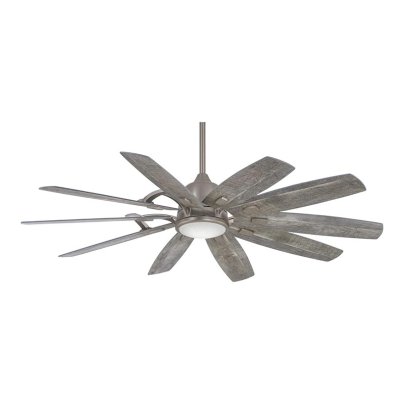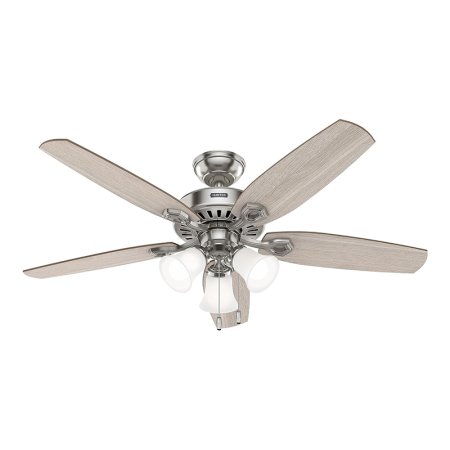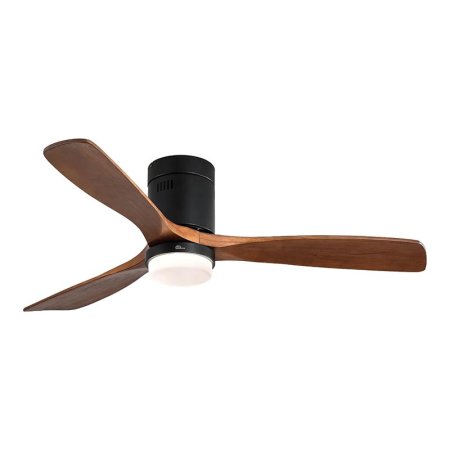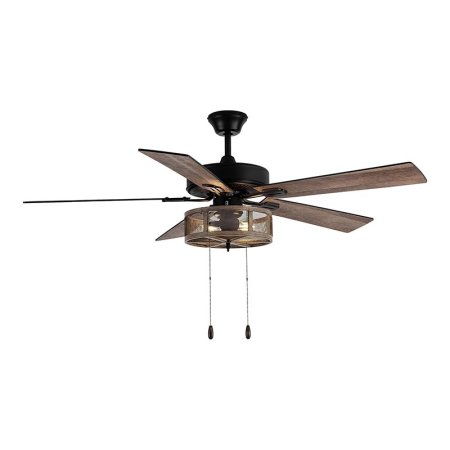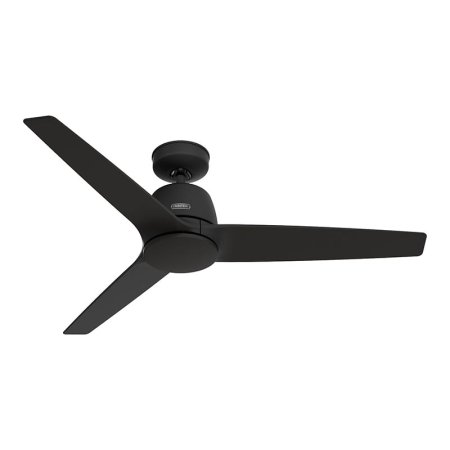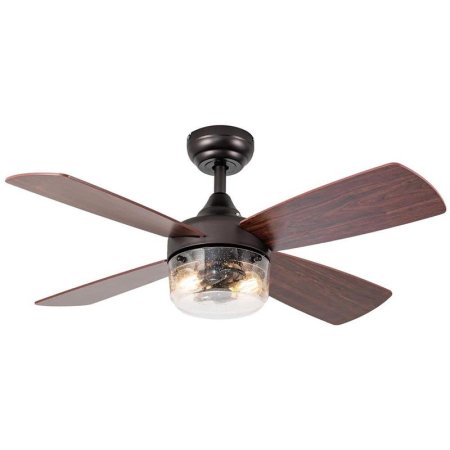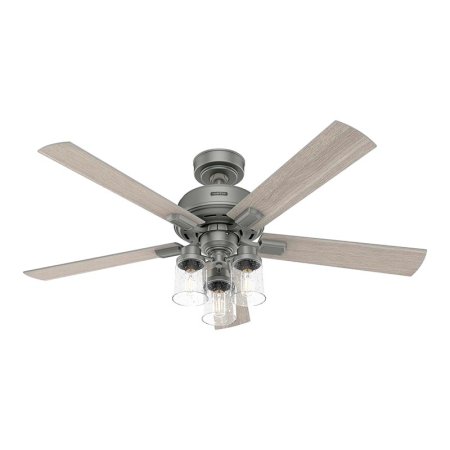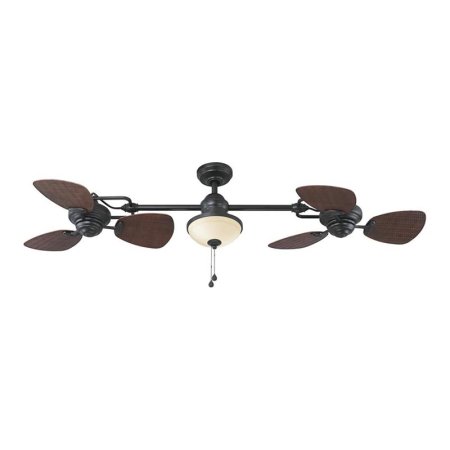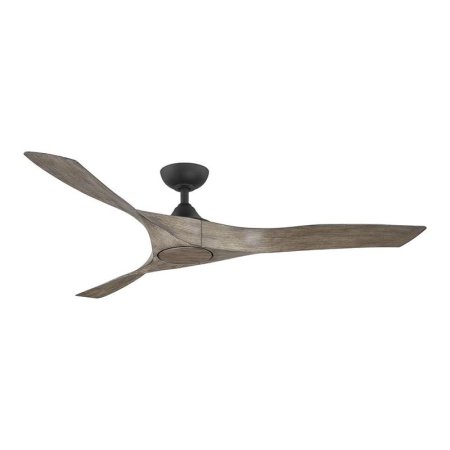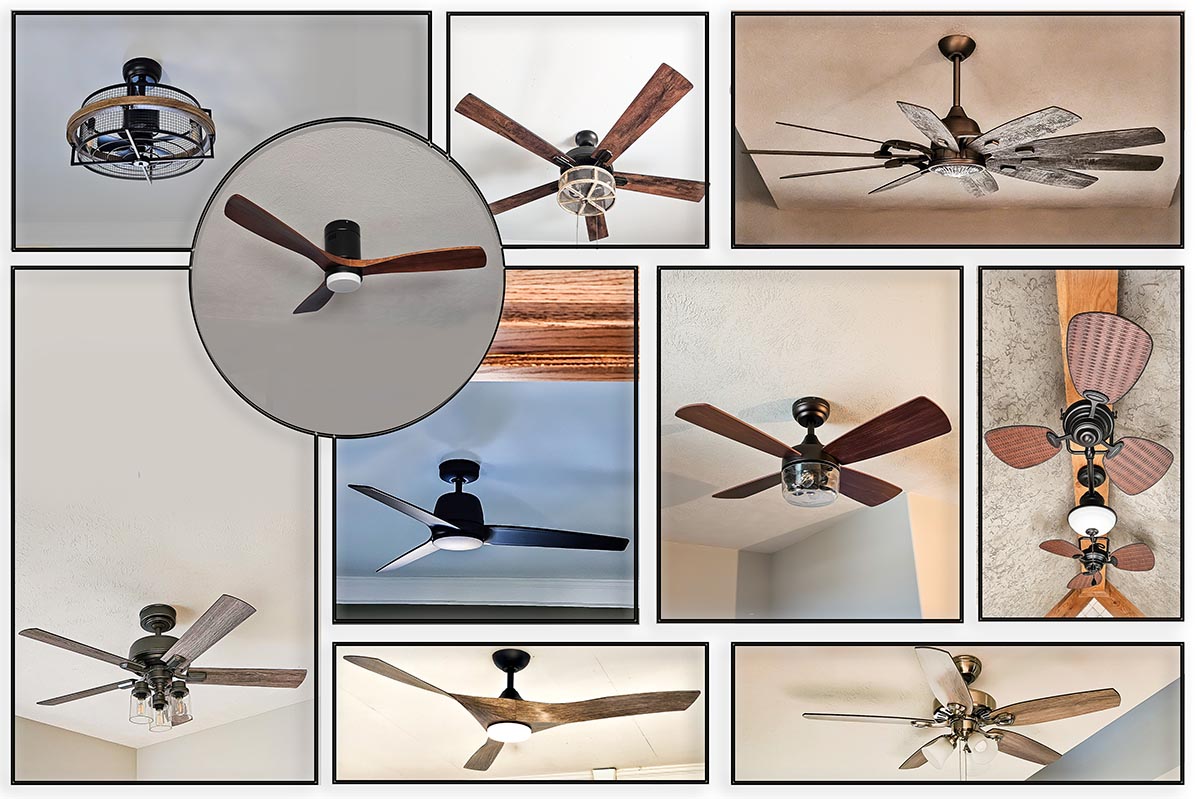
We may earn revenue from the products available on this page and participate in affiliate programs. Learn More ›
Ceiling fans provide a cost-effective and elegant way to make living spaces more comfortable. They don’t lower the room temperature, per se; instead, they circulate air throughout a space, making those in the room feel cooler by helping warm air evaporate from the skin.
Today’s ceiling fans come in various sizes and styles; some even offer smart connectivity. We wanted to develop a roundup of top-performing ceiling fans in several categories, so we tested a bunch of them ourselves. We started by researching more than 40 different models before narrowing our list to 10, which we then installed and tested extensively.
If you’re in the market for a ceiling fan, keep reading. We’ll tell you which features to look for, and you’ll find out how the following models earned a spot in our lineup of the best ceiling fans.
- BEST OVERALL: Minka-Aire Barn 65″ LED Smart Ceiling Fan
- BEST BANG FOR THE BUCK: Hunter Builder 52″ Ceiling Fan With Light
- BEST FLUSH-MOUNT: Sofucor 52″ Flush Mount Steel Wood Ceiling Fan
- BEST RUSTIC: River of Goods Farmhouse 52″ Ceiling Fan
- BEST FAN-ONLY: Hunter Malden 52″ Ceiling Fan
- BEST FOR MEDIUM ROOMS: River of Goods Yvette 42″ 2-Light Ceiling Fan
- BEST CAGE-STYLE: Parrot Uncle 20″ Industrial Downrod Mount Fandelier
- BEST FOR LARGE ROOMS: Hunter Hartland 52″ LED Ceiling Fan
- BEST DOUBLE FAN: Harbor Breeze Twin Breeze 74″ Ceiling Fan
- BEST SMART OUTDOOR: Wind River Willow 60″ Ceiling Fan
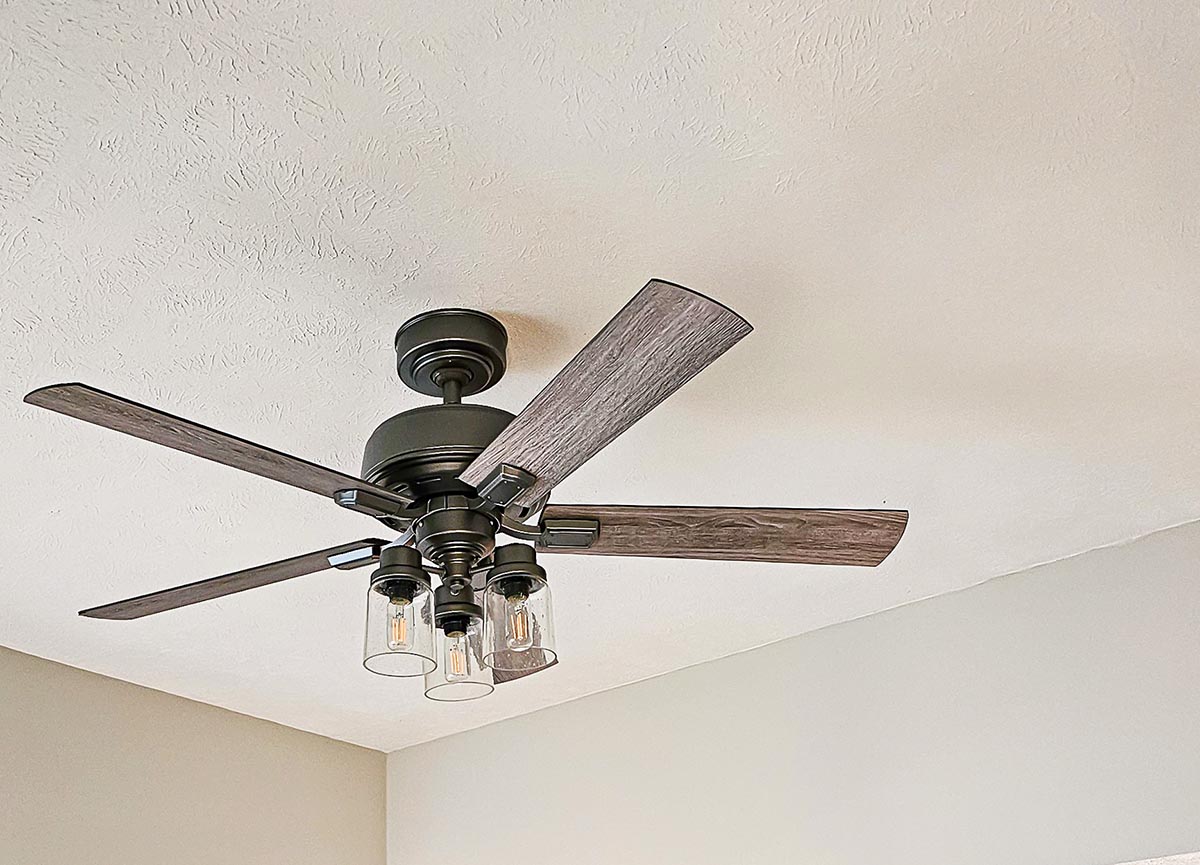
How We Tested the Best Ceiling Fans
Selecting ceiling fans for testing involved carefully researching the best-selling models to determine which ones offered features that consumers were most likely to want. We considered brand name to an extent—after all, manufacturers like Hunter and Harbor Breeze consistently earn top honors for their high-quality fans. Still, we didn’t discriminate against smaller or niche brands—if their ceiling fans were well made and had high customer satisfaction, we took them into consideration.
We also considered each fan’s control type, design style, airflow rating as measured by its cubic feet per minute (CFM), and other special features.
In actual testing, we installed the fans in our own homes—wiring them according to the manufacturers’ specs—and noted how difficult the installation was. Then, we turned them on using a wall switch, remote control, or smart features and observed their stability to see if they wobbled or if they were well-balanced fans right out of the box. We tested every feature each fan offered (although the majority of testing time was taken up by installing each fan) and awarded points based on a rubric. The better a ceiling fan performed on a test, the more points it earned.
| Testing Stats | |
| Products tested | 10 |
| Hours spent testing | 18 hours |
| Tests performed | 4 |
| Average price | $248.96 |
Our Top Picks
Aesthetics play a significant role in choosing a ceiling fan, and the following models encompass a range of classic and trending interior design styles. Whether you’re looking for a fan for strictly practical purposes or you want a sleek, stylish fan to complement your home’s decor, you’ll find one here that is tested and approved. Installing a ceiling fan requires wiring the fan to the home’s electrical system, so if you’re not comfortable working with wiring, have an electrician install it.
Best Overall
Minka-Aire Barn 65" LED Smart Ceiling Fan
Our Ratings: Installation 5/5; Stability 5/5; Airflow 5/5; Control 4/5; Value 5/5
Product Specs
- Blade span: 65 inches
- CFM: 3,712 to 9,155
- Built-in light: Yes
- Dry/wet rating: Dry (indoor)
- Controls: Remote control, app
What We Like
- Fan contains a built-in remote receiver, making it easier to install and configure
- 10-inch downrod drops the level of the fan for sloped ceiling clearance
- Very smooth operation; no wobbling on startup or at any fan speed
- Whisper-quiet fan; didn’t even register on our decibel tester
- Can be controlled via wall switch, remote control, or Bond Home app on smart devices
What We Don’t Like
- On the pricey side compared to the other fans we tested
The 65-inch Minka-Aire ceiling fan stands out for its ever-popular farmhouse style, but it’s also a top-notch performer in its own right. When we unboxed this barn-style fan and found ten blades and many nuts, bolts, and connectors, we had a sinking feeling it would take well over an hour to assemble. Not so—it took less than 45 minutes to put it together.
We installed the Minka-Aire on a sloped ceiling with a 4:12 pitch. A 10-inch drop bar made it possible to hang it on the slope without the wide blades hitting the lower ceiling edge.
This fan really moves some air. It was easy to turn it on and off and adjust the blade speed using the remote control. Dimming the light was a little more challenging. The remote has a dual-light switch, and by reading the instructions, we learned that we had to depress one button while simultaneously pressing the other to increase the intensity or dim the light. A simple up/down dimmer switch would have been more user-friendly, but that’s only a slight downside.
Overall, the Minka-Aire is a standout pick. It features reversible blades for both winter and summer use. It comes with smart connectivity. We downloaded the Bond Home app, which quickly synced to our wireless network, allowing us to operate the fan via smartphone.
If you’re looking for a sizable ceiling fan that runs every bit as good as it looks, you won’t be disappointed with the Minka-Aire.
What Our Expert Says: “This fan is exceptionally quiet—it didn’t even register on our decibel tester while it was running. I love that I can be in my home and not even hear the fan running.” — Glenda Taylor, Bob Vila Staff Writer and Product Tester
Read our full review: Minka-Aire Barn 65″ LED Smart Ceiling Fan
Get the Minka-Aire ceiling fan at Amazon or The Home Depot.
Best Bang for the Buck
Hunter Builder 52" Ceiling Fan With Light
Our Ratings: Installation 4/5; Stability 4/5; Airflow 4/5; Control 5/5; Value 5/5
Product Specs
- Blade span: 52 inches
- CFM: Maximum 4,339
- Built-in light: Yes
- Dry/wet rating: Dry
- Controls: Pull chain
What We Like
- A sturdy, well-made fan at an affordable price point
- Traditional ceiling fan suitable for most interior decor styles
- Quiet while running at high speeds and virtually silent on low
- Reversible blades for use in both summer and winter seasons
What We Don’t Like
- Remote not included (though it can be purchased separately), so versatility is limited
This reasonably priced ceiling fan from Hunter is ideal for small to medium-size rooms, and it boasts many of the same features as higher-priced models. It comes with reversible blades and three flared glass globes compatible with standard light bulbs. Those looking for good air circulation in a classic style that doesn’t create a lot of noise or cost a fortune might want to consider the Hunter Builder.
During testing, we found installation to be standard and straightforward. The instructions came with clear illustrations that were simple to understand and follow. Like the other ceiling fans we installed and tested, the Hunter Builder attaches to a standard ceiling light box, so it’s just a matter of removing the existing light and installing the fan in its place.
This is not a flush-mount fan, but with its short 3-inch downrod, it’s still a good option for standard 8-foot ceilings and gently sloping ceilings. Users can run its reversible motor in the colder months to push warmer air downward and reduce heating costs. In our tests, the fan ran smoothly in both directions without wobbling. And, because it has a DC motor, it’s very quiet.
Our only complaint—and it might not matter to others—is that the fan doesn’t come with a remote control, so we had to use pull chains to turn the blades and the lights on and off. For anyone who doesn’t mind walking to the center of the room to pull on a chain, the Hunter Builder fan is a great pick at an affordable price point.
Get the Hunter Builder ceiling fan at Amazon, Lowe’s, or The Home Depot.
Best Flush-Mount
Sofucor 52" Flush Mount Steel Wood Ceiling Fan
Our Ratings: Installation 4/5; Stability 4/5; Airflow 5/5; Control 5/5; Value 4.5/5
Product Specs
- Blade span: 52 inches
- CFM: 2,850 to 5,128
- Built-in light: Yes
- Dry/wet rating: Dry/damp (indoor or protected outdoor)
- Controls: Remote control
What We Like
- Sleek, modern design serves as a stylish complement to contemporary decor
- Real wood blades, which resemble an airplane propeller, are a nice upgrade
- LED light comes with temperature control—select from cool white, warm, or natural
- Reversible blades make this fan an energy-efficient choice for summer and winter
- User-friendly remote control allows users to adjust blade speed and light intensity remotely
What We Don’t Like
- Although this is a flush-mount ceiling fan, it will require an 8-foot ceiling
- LED light is not super bright, but suitable for most bedroom and living room uses
With its rich-tone wood blades and flush-mount base, the Sofucor ceiling fan boasts a sleek look suitable for homes with modern or contemporary decor. Installing it requires a minimum ceiling height of 8 feet because the fan extends downward just over 11 inches. While some flush-mount fans are designed for lower ceilings, the Sofucor isn’t.
We liked the fan’s genuine wood blades, which look like an airplane propeller. The fan also comes with its own LED light. It isn’t as bright as we would like, but we did appreciate being able to select the light color (warm, natural, or cool white), as this allowed us to change the light quality in the room to suit our mood.
Installation was straightforward. The fan came with a small instruction booklet, and more complete instructions are available by scanning the UR code in the booklet. The only thing we would have changed about the installation was the need to install the blades before connecting the housing to the mounting plate. While this is doable, with most ceiling fans, the housing installs before the blades, because the blades tend to get in the way if they’re installed first. Still, we had no problems, and the wiring setup was standard.
A user-friendly remote controls the fan. Adjusting the blade speed, direction, and the lights from the remote was easy. This is a very quiet fan—we barely heard it on low, and on high, it was just a whisper. Those who want modern appeal in a ceiling fan won’t go wrong with the Sofucor.
Get the Sofucor ceiling fan at Amazon or Sofucor.
Also sold under the name Nicola by George Oliver at Wayfair.
Best Rustic
River of Goods Farmhouse 52" Ceiling Fan
Our Ratings: Installation 3/5; Stability 4/5; Airflow 5/5; Control 4/5; Value 5/5
Product Specs
- Blade span: 52 inches
- CFM: Maximum 4,278
- Built-in light: Light kit
- Dry/wet rating: Dry (indoor)
- Controls: Pull chains
What We Like
- Attractive rustic style with barnwood- and driftwood-finish blades available
- Provides ample air circulation for medium-size rooms, such as dens or dining rooms
- Reversible blades make this fan suitable for warm and cool seasons
What We Don’t Like
- No remote control, so users must operate the fan via pull chains
This rustic ceiling fan from River of Goods exudes farmhouse charm. Featuring reversible 52-inch blades (users can choose from a barnwood or driftwood finish), it’s ideal for medium-size rooms, such as a bedroom, dining room, or den.
We really liked this fan’s unique style and countryside feel. While the ceiling fan installation was similar to most models, we had a bit of trouble attaching the cage-type light kit beneath the fan blades. A bit of metal that probably should have been removed from the bracket was still there, which made it impossible to attach the light kit until we filed off the errant piece. After that, the rest of the installation went smoothly.
This ceiling fan makes a little noise, but not so much that we found it distracting. It has an AC motor, which is known to be louder than DC motors, but even at the highest speed, the sound wasn’t distracting. In fact, as is the case with many fans, the sound faded into the background after a while, and we stopped noticing it.
The fan comes with reversible blades, which make it well suited for both warm- and cool-weather use, but it doesn’t come with a remote, so we had to flip a switch on the housing when we wanted to change blade direction. Pull chains operate the lights and blades, and the light kit accepts two standard light bulbs (included).
This River of Goods fan doesn’t come with many bells and whistles, but it’s a great pick if you’re looking for a fan that circulates air well and captures that iconic farmhouse style.
Get the River of Goods Farmhouse ceiling fan at Amazon, Lowe’s, The Home Depot, or Walmart.
Best Fan-Only
Hunter Malden 52" Ceiling Fan
Our Ratings: Installation 5/5; Stability 5/5; Airflow 5/5; Control 4/5; Value 5/5
Product Specs
- Blade span: 52 inches
- CFM: Maximum 4,791
- Built-in light: No
- Dry/wet rating: Dry
- Controls: Remote control
What We Like
- Part of the sleek and stylish Jasmine Roth collection by Hunter
- Straightforward installation makes it quick and simple to install
- Smooth and wobble-free blade operation on all 3 speeds
What We Don’t Like
- No remote option for reversing blade direction switch on fan housing
- No light kit—best suited for rooms that already receive plenty of light
Chic and understated, our next pick is part of the Jasmine Roth collection. Roth, an interior designer, host, and star of HGTV’s Hidden Potential and Help! I Wrecked My House, offers the Malden indoor ceiling fan in conjunction with the Hunter Fan brand. It’s the perfect air-circulation accessory for any room in the house.
This fan doesn’t have a built-in light or the option to add a light kit, so it’s best suited for rooms that are already well lit or have ample natural light sources, making extra light on the ceiling unwanted and unnecessary. We tested the Malden in its standard version with a 3-inch downrod; other rod lengths are also available. This model comes with three 52-inch blades and a smooth, contoured housing that gives it a snazzy, high-tech look.
The Malden was straightforward to install. Less than 30 minutes after unboxing, we were using the remote to turn the fan on. If users prefer not to use a remote in perpetuity, they can turn the fan on (with the remote) and then turn the Malden on and off directly from the connected wall switch going forward.
The Hunter has an AC motor that runs as quietly as many DC motors, generating no more sound than a whisper. It can run at three speeds and operates smoothly and wobble-free on all of them. The blades are reversible, but only from a switch on the fan housing—not from the remote. And crucially, the fan generates a high level of consistent airflow.
Those looking for a fan-only option with sleek designer appeal could find a lot to love about the Hunter Malden ceiling fan from the Jasmine Roth collection.
Read our full review: Hunter Malden 52″ Ceiling Fan
Get the Hunter Malden ceiling fan at Amazon, The Home Depot, or Hunter Fan.
Best for Medium Rooms
River of Goods Yvette 42" 2-Light Ceiling Fan
Our Ratings: Installation 4/5; Stability 5/5; Airflow 5/5; Control 4/5; Value 4/5
Product Specs
- Blade span: 42 inches
- CFM: N/A
- Built-in light: Yes, light kit
- Dry/wet rating: Indoor
- Controls: Remote control
What We Like
- Nicely bronzed casing and mahogany-finish blades create a striking look
- Produces ample airflow in medium-size rooms and can be controlled by remote
- Blades are reversible for use during both summer and winter months
What We Don’t Like
- AC motor produces slightly more noise than some other fans, but it’s a soothing sound
A nice departure from the traditional three-flared light kit, the River of Good’s Yvette ceiling fan features a thick glass shade embellished with a smattering of bubbles reminiscent of hand-blown glass. We really liked the lighting effect in the room that was created by the shade—it was flattering and uniform, with all areas of the room receiving the same amount of light.
Assembly took over an hour, but that was because we were missing a screw (we may have dropped it somewhere), so we had to buy a replacement screw from the hardware store. Other than that, putting the Yvette together was simple. It comes with two LED bulbs, nicely bronzed casing, and rich-looking mahogany blades that create a stunning look against a light-colored ceiling.
The Yyvette has reversible blades and three speeds, which users can select via the included remote. The only downside we noticed is that this fan is slightly more noisy than some of the others we tested. It wasn’t bad—the sound resembled white noise—but it wasn’t whisper quiet.
This nice-looking fan moves quite a bit of air, and the remote is user-friendly. If you want an attractive fan and you like white noise, the Yvette may be just the ticket. It’s a very nice fan.
Get the River of Goods Yvette ceiling fan at The Home Depot, Walmart, or Bed Bath & Beyond.
Best Cage-Style
Parrot Uncle 20" Industrial Downrod Mount Fandelier
Our Ratings: Installation 5/5; Stability 5/5; Airflow 4/5; Control 5/5; Value 5/5
Product Specs
- Blade span: 20 inches
- CFM: 1,095 maximum
- Built-in light: Yes
- Dry/wet rating: Dry
- Controls: Remote control
What We Like
- Compact, trendy design offers modern-industrial look with black iron elements
- Blades and lights are contained within cage, so fan does not overwhelm the look of the room
- Despite its compact size, fan provides a soothing breeze throughout medium-size rooms
- Simple and straightforward installation, taking about 30 minutes from start to finish
- Reversible fan blades for use during both winter and summer seasons
What We Don’t Like
- Not a silent fan, but not so loud as to be annoying either
Cage-style ceiling fans are trending, and it’s easy to see why. Rather than featuring long blades that overwhelm a ceiling, cage fans are composed of wire or wood cages that contain miniature blades and light kits, all in a compact unit. Many, including this Parrot Uncle ceiling fan we tested, offer a modern-industrial look with black iron elements.
We liked the fan’s look, but we weren’t sure how well it would circulate the air given its size. We needn’t have worried—the Parrot Uncle provided a soothing breeze in our test room, which measures 15-feet square.
Installation was easy and quick. It took about 30 minutes to install the Parrot Uncle and start it up using the included remote. Like another couple of AC motor fans we tested, this cage fan was slightly noisier. That’s not to say it was loud, but the DC motor fans we tested were virtually silent, so we noticed the difference.
The fan is fully controllable from the remote and users can reverse the direction in which the blades spin for year-round use. It’s a nice-looking fan with trendy industrial elements that will keep the air fresh in your room. It won’t blow you away, but you’ll feel cooler and more comfortable when it’s running.
Get the Parrot Uncle ceiling fan at Lowe’s, The Home Depot, or Walmart.
Also sold under the name Rishel by Trent Austin Design at Wayfair.
Best for Large Rooms
Hunter Hartland 52" LED Ceiling Fan
Our Ratings: Installation 4/5; Stability 5/5; Airflow 5/5; Control 5/5; Value 4.5/5
Product Specs
- Blade span: 52 inches
- CFM: Maximum 5,634
- Built-in light: Yes, light kit
- Dry/wet rating: Indoor
- Controls: Remote control
What We Like
- Attractive, upgraded design is equal parts traditional and contemporary
- Included remote control can be mounted over the room’s wall switch for convenience if desired
- Fan is well made and glass on the light kit offers a luxurious look and feel
What We Don’t Like
- Included light bulbs were on the dim side and had to be replaced
- Blades are not reversible; as such, fan is best suited for summer use
This was one of the most attractive traditional-style ceiling fans we tested. On top of that, we liked that it comes with a remote control that effectively replaces the operation of the wall switch.
It took almost an hour to install the Hunter Hartland because there were several parts, and we had trouble getting the old fan off the ceiling. But this is a very well-made fan—everything about it suggests durability and quality workmanship.
Hunter really went all out with this one and it shows. The light kit is impressive—the glass shades feature thick, seeded glass, which adds a luxurious touch to the look of the fan. The included light bulbs, however, were pretty dim. After we installed the bulbs that came with the fan, we tried to increase the intensity, but they were as bright as they would go. We ended up buying different bulbs so the room could be well lit.
The remote is a nice perk. It fits into a holder that can be mounted on the wall or over the existing light switch, whichever you prefer. When mounted, we used the main button on the front of the remote to turn the light on and off just as we would with the switch. This allowed us to also remove the remote and flip the switch by hand if we wanted.
The blades are not reversible, which is a slight drawback, but if you’re looking for summer cooling from a ceiling fan, it doesn’t get much more attractive than the Hunter Hartland. It moves a lot of air and will keep even large rooms fresh and ventilated.
Get the Hunter Hartland ceiling fan at Amazon, Lowe’s, or The Home Depot.
Best Double Fan
Harbor Breeze Twin Breeze 74" Ceiling Fan
Our Ratings: Installation 4/5; Stability 4/5; Airflow 4/5; Control 4/5; Value 5/5
Product Specs
- Blade span: 74 inches
- CFM: Maximum 4,450
- Built-in light: Yes
- Dry/wet rating: Indoor, protected outdoor
- Controls: Pull chains (remote control sold separately)
What We Like
- Unique look with double fans that will add style to indoor or outdoor protected areas
- Reversible blades make this fan energy efficient in both summer and winter
- Relatively quiet even though it comes with an AC motor
What We Don’t Like
- No remote control, which may limit convenience in some situations
It’s hard to beat the appearance of the dual-fan Twin Breeze, which features a three-bladed fan at each end of a support bar with a light in the center.
Installation was a little tricky with this one due to its configuration and the need to support a long bar while connecting wires. We discovered we needed to stabilize the rod on the Twin Breeze to keep it from rotating when we pulled the fan or light chain. This might not have been a big deal, except we tested this fan at the highest point of an indoor three-season room’s ceiling, and if it rotated, the blades would have struck the sloped interior of the ceiling.
Once we got it installed and stabilized, it ran very well—it didn’t create much noise, even though it has an AC motor. The Twin Breeze is designed for protected outdoor and indoor use, so it can also be installed on a covered porch or patio. It features reversible blades, too. The light kit is nice but not super bright, so those who like more light can upgrade to brighter bulbs. It accepts standard-size bulbs.
The Twin Breeze is easy to operate via pull chains, but we had to purchase longer ones because we installed it in the peak of a gable. An included remote would be the icing on the cake. It does have remote control adaptability, but the remote control must be bought separately. Nonetheless, this is a nice fan that will upgrade the look of an outdoor or indoor space.
Get the Harbor Breeze ceiling fan at Amazon or Lowe’s.
Best Smart Outdoor
Wind River Willow 60" Ceiling Fan
Our Ratings: Installation 5/5; Stability 5/5; Airflow 5/5; Control 5/5; Value 4.5/5
Product Specs
- Blade span: 60 inches
- CFM: Maximum 6,131
- Built-in light: Yes
- Dry/wet rating: Dry, protected outdoor
- Controls: Remote control, app
What We Like
- Powerful yet quiet air circulation—good for offering relief in hot outdoor conditions
- Attractive propeller design resembles wood and adds an appealing look for those who want an outdoor ceiling fan
- Easy, straightforward installation takes about 30 minutes from start to finish
- Smart connectivity allows users with wireless networks to operate the fan from their smartphones
What We Don’t Like
- Blade spin is not reversible, which might be a drawback for those who install this fan indoors
- Pricier than many fans we tested, which might reduce its value for some users
Porches and patios will feel more comfortable with the Willow by Wind River. The large 60-inch blade span moves a lot of air—enough to offer relief in sweltering heat. We tested the Willow fan on a covered patio that measures 16 feet long by 16 feet wide, and we could feel a strong breeze even when we stood at the edges of the patio.
The Willow offers an attractive look with its three propeller-style blades (which look and feel like wood but are most likely a composite material). Installation was straightforward, and we got the fan up and running in about 30 minutes. It comes with a 4.5-inch downrod that’s just about right for installing on a covered 8-foot ceiling.
In addition to the remote we used to operate the outdoor fan even when standing in the house, the Willow also can be conveniently controlled with the smart Bond Home app. We downloaded and synced the app with our wireless network without any problems, and once connected, we were able to turn the fan on and off and select the color value of the LED light from our smartphones.
The fan does not come with reversible blades, but if you’re using it in a covered outdoor spot, you likely won’t need them because heat will not be gathering under the porch or patio roof. If you install the Willow indoors, you might miss this option.
This fan is nearly quiet as it runs—a benefit of having a DC motor.
Get the Wind River ceiling fan at Amazon, Bed Bath & Beyond, or Houzz.
Also sold under the name Mercury Row Ferland at Wayfair.
Jump to Our Top Picks
What to Consider When Choosing a Ceiling Fan
Various factors go into choosing the best-quality ceiling fans for your home, including the intensity of airflow you want as well as the size of the room. And if you have rooms with low ceilings, you’ll need low-profile fans. The location also makes a difference, as some fans are designed for both indoor and outdoor use while others are not. Ease of installation is another crucial element. And don’t forget about the style—a model with a fantastic design is challenging to say no to.
Size
Consider the space in which the fan will be installed. First, calculate the space’s square footage, and then use that number to determine the appropriate blade span. “Blade span” measures the distance from the end of one blade to the end of the opposing blade. Ceiling fans range from 15 inches to 80 inches across. Consider the following Energy Star size recommendations:
- Up to 75 square feet: blade span of 36 inches or smaller
- 75 to 144 square feet: blade span of 36 to 42 inches
- 144 to 225 square feet: blade span of 44 inches
- 225 to 400 square feet: blade span of 50 to 54 inches
The appropriate height for a ceiling fan is 8 or 9 feet, measured from the floor to the fan blades. Make sure you factor in the measurements of the included downrod to determine how high or low the ceiling fan will sit once installed. For low ceilings, consider a flush-mount or low-profile fan, as these tend to anchor the fan very close to the ceiling. For high ceilings, you’ll likely want an extended downrod, which allows the fan to be positioned lower for optimal positioning.
Keep in mind that a ceiling fan’s height has a bearing on how easy it is to clean the fan. The higher the fan, the taller the ladder you’ll need to adequately clean it.
Airflow
The best ceiling fans have a high airflow efficiency. Airflow efficiency refers to the amount of air the fan circulates on the highest fan setting measured in CFM. In open outdoor spaces, a high CFM is desirable for circulating the air and helping to keep insects at bay. An average CFM for a 52-inch fan is around 4,000 CFM, but this can range up to 10,000 CFM.
The number of blades does not significantly affect a ceiling fan’s CFM; the blade count is more of an aesthetic feature than a utilitarian one. When selecting a ceiling fan, consider selecting a CFM factor that fits your preferred style and budget.
Energy Efficiency
If you typically set your thermostat to 74 degrees Fahrenheit, adding a ceiling fan would theoretically allow you to adjust your thermostat up to 78 degrees Fahrenheit without feeling a noticeable difference in ambient temperature thanks to the fan’s cooling effects. That’s a benefit that can translate into significant energy savings over time.
You can save more on utility bills by buying a ceiling fan/light combo that meets the government’s Energy Star standards. By selecting an Energy Star–certified fan/light combo over a nonrated counterpart, you could save up to 40 percent on the fan’s annual operating costs.
Lighting
Many ceiling fans include integrated lighting or an optional light kit. Ceiling fans without lighting can sometimes be modified with a compatible light kit if desired later on. LED bulbs are preferred for these fixtures since they surpass incandescent, compact fluorescent lamps, and halogen bulbs in longevity and energy efficiency.
Light bulbs come in many shapes, from round, globelike bulbs to vintage-style Edison bulbs. Brightness levels (measured in lumens) also vary across lighting options. The best ceiling fans with lights will emit at least 800 lumens to illuminate an entire room.
Also, take note of the color temperature of the lighting. Cool lights tend to have a blue hue, while warm lights have a yellow hue. Warm lights tend to be favored for an outdoor ceiling fan; they give the space an attractive glow as opposed to the stark lighting of cool bulbs.
Location
Ceiling fans are assigned ratings to indicate the conditions in which their installation is deemed safe. If your fan may be exposed to high humidity or water splashes, be sure to choose the appropriate rating.
- Dry-rated: These are indoor fans designed for installation in family rooms, bedrooms, dining rooms, and other rooms not subject to high humidity.
- Damp-rated: These ceiling fans will withstand high levels of humidity, such as those found in a steamy bathroom or laundry room, but they should not be installed where they can be splashed with water directly. They may also be used in all rooms suited to a dry-rated fan.
- Wet-rated: Looking to keep cool on your covered porch or patio? You’ll need a wet-rated fan. These fans feature sealed motor housing units that will withstand precipitation.
Operation
Ceiling fans are available as basic pull-chain models or savvier tech-forward designs. Common control methods include pull chains, remote controls, wall controls, and smart technology.
- Pull chain: This is a basic, budget-friendly option ideal for low- to average-height ceilings. These standard fan types have hanging pull chains that cycle from one fan speed to the next each time the user tugs the chain.
- Remote control: These ceiling fans include handheld remote controls that control the fan from within a close range. This is a convenient pick that allows users to adjust the fan without having to get up.
- Wall control: These models have controls similar to light switches, allowing the user to operate the fan from a switch or button on the wall. While less convenient than those with a remote control, there is no chance of losing a wall switch. Remote control and wall-switch fans tend to be costlier than pull-chain options. They are popular for spaces with high ceilings.
- Smart: Fans with smart technology connect to Bluetooth or Wi-Fi and can be controlled by an app on a smartphone or other device. While these models tend to be pricey, they’re the most convenient to operate.
- Reversible blades: Some fans are designed with blades that reverse directions. In warm weather, they create a soothing breeze, and in winter, users can reverse the direction of the blades to push cold air upwards, displacing it with warmer air that otherwise would rise toward the ceiling.
Style
For many, a ceiling fan’s aesthetic is just as important as functionality. A variety of designs and finishes are available to suit different indoor spaces. The best ceiling fans tend to complement the surrounding decor style.
- Modern: Clean lines and smooth finishes define the modern decor style. Sleek and slim blade designs with a brushed or satin finish will fit in with modern spaces.
- Midcentury: Many sleek, modern ceiling fans are also well suited to midcentury spaces. Midcentury design favors many of the minimalist elements of the modern style, but it can also incorporate a retro twist or pops of color. If the goal is to make a statement, then funky or geometric-shaped fan blades can add some interest to the ceiling decor.
- Industrial: Combining modern elements with functional rawness, industrial decor is inspired by factories, warehouses, and industrial structures. Stripped-back details like metal beams and exposed brick contribute to this clean style. To suit the neutral tones and industrial materials of this style, opt for metallic, white, gray, or black ceiling fans with sleek fan blades.
- Rustic: Rustic decor has an aged, homey, and cozy feel to it, featuring natural elements like exposed wooden beams, thick wooden furniture, and distressed textiles. It tends to use a lot of other wooden elements and incorporate an unfinished and almost homemade look with lots of earthy colors. Simpler wood-grain ceiling fans can fit in with rustic decor. Opt for those with a natural or mahogany finish for a cozy feel.
- Farmhouse: Similar to the rustic style, farmhouse design tends to include natural materials like wood. Farmhouse aesthetic tends to have a lighter and fresher feel than dark rustic rooms, using traditional designs, lighter wood grains, and colored woods. Similar to those used in rustic rooms, wood-grain ceiling fans give a clean and homey feel. Neutral wood and lighter colors lighten up the design, and Edison-style bulbs can also add a charming appeal.
- Coastal: For a coastal decor style, consider fans with a natural and beachy look with warm, neutral tones. Choose fans with blades that mimic the appearance of wood, complemented by neutral shades of cream, white, or pastels to harmonize with the breezy aesthetic. Some coastal-style fans also feature light fixtures that mimic the look of a lighthouse lantern.
- Tropical: Tropical decor is another nature-inspired decor style. Natural materials and textures skew toward a more colorful tropical theme. For a more subdued look, go neutral with materials like bamboo and rattan, or make a statement with colorful leaf or flower blade designs or patterns.
Installation
Installing a ceiling fan is a relatively easy task if it involves replacing an existing light fixture. These projects typically require tools such as a ladder, utility knife, screwdriver, pliers, and an adjustable wrench. You may also need a ceiling outlet box, keyhole saw, or wire strippers.
The basic installation process involves turning off the power to the fixture, mounting the body of the ceiling fan, connecting the wiring, and then attaching the blades to the motor. If any additional wiring is required, we recommend enlisting the help of an electrician. Once installed, ceiling fans do not generally require much maintenance aside from regular cleaning and dusting.
FAQs
For more information about the best ceiling fan, check out these answers to some of the most frequently asked questions. If additional concerns arise, contact the manufacturer.
An average CFM for a 52-inch ceiling fan is around 4,000 CFM, but this can range up to 10,000 CFM. The higher the CFM, the stronger the airflow. The number of fan blades does not affect a ceiling fan’s CFM much—the blade count is more of an aesthetic feature than a utilitarian one.
Look for a ceiling fan with at least 800 lumens if you want to illuminate an entire room.
A 12-foot-square room is equivalent to 144 square feet. You can choose between the following blade spans for a space of that size.
75 to 144 square feet: blade span of 36 to 42 inches
144 to 225 square feet: blade span of 44 inches
Yes. If a room has low ceilings, you’ll want a low-profile fan that installs flush to the ceiling. You wouldn’t want to be hit by the fan while it’s running.
Meet the Tester
Glenda Taylor is a product tester and writer specializing in the construction, remodeling, and real estate industries. She and her husband own a general contracting company, and Taylor is experienced in both residential and commercial building applications. She tests a wide range of power tools as well as other home improvement, household, and lawn-and-garden products.
Additional research provided by Tiffany Lewis.
